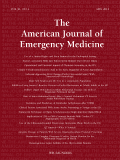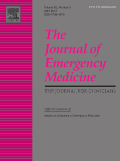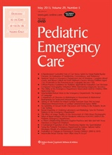
Canadian Journal of Emergency Medicine
Scope & Guideline
Advancing Emergency Care Through Rigorous Research
Introduction
Aims and Scopes
- Clinical Guidelines and Best Practices:
The journal publishes research aimed at establishing and updating clinical guidelines and best practices for emergency medicine, ensuring that practitioners have access to the most current evidence to inform their clinical decisions. - Emergency Medical Education:
CJEM places a strong emphasis on educational strategies within emergency medicine, including training for residents and practicing physicians, as well as the integration of simulation and point-of-care ultrasound (POCUS) into curricula. - Health Policy and Systems:
The journal addresses the intersection of emergency medicine with health policy and systems, focusing on topics such as access to care, healthcare utilization, and the impact of systemic factors on emergency services. - Trauma and Critical Care:
Research related to trauma care, including resuscitation techniques, management of critical conditions, and innovative trauma care protocols, is a core focus area of the journal. - Patient-Centered Care and Equity:
CJEM highlights studies that explore patient-centered approaches to emergency care, including considerations of social determinants of health and efforts to improve equity in access and treatment. - Mental Health and Substance Use:
The journal features research on the management of mental health crises and substance use disorders within the emergency setting, reflecting the growing recognition of these issues in emergency medicine.
Trending and Emerging
- Use of Point-of-Care Ultrasound (POCUS):
POCUS has gained significant attention in recent publications, with increasing studies focusing on its applications in various emergency scenarios, highlighting its role in enhancing diagnostic accuracy and patient management. - Mental Health Interventions:
Research on mental health crises and interventions within the emergency department setting is increasingly prevalent, reflecting a growing recognition of the need for comprehensive mental health care in emergency medicine. - Addressing Health Equity:
Emerging studies focus on health equity issues, particularly regarding access to emergency care for marginalized populations, indicating a shift towards understanding and addressing systemic barriers. - Technology Integration in Emergency Care:
The integration of technology, including virtual care models and telemedicine, is becoming a prominent theme, as the field adapts to new methods of providing care, especially in light of the COVID-19 pandemic. - Trauma and Resuscitation Innovations:
Innovations in trauma care, including the use of advanced resuscitation techniques and protocols, are increasingly featured, reflecting ongoing advancements in critical care practices within emergency medicine.
Declining or Waning
- Traditional Diagnostic Imaging Techniques:
There has been a noticeable decrease in papers focused solely on traditional imaging techniques, such as CT scans, in favor of more innovative approaches like POCUS and other bedside diagnostic tools. - General Emergency Medicine Protocols:
The journal has seen a reduction in the publication of broad emergency medicine protocols that do not address specific conditions or populations, indicating a shift towards more specialized and targeted research. - Historical Perspectives on Emergency Medicine:
There is a decline in publications that reflect on historical practices or the evolution of emergency medicine, suggesting a greater focus on contemporary issues and future directions rather than retrospective analyses. - Non-Emergency Conditions in Emergency Settings:
Research addressing non-emergency conditions or those that could be managed outside of emergency settings has decreased, reflecting a trend towards prioritizing acute care and emergency-specific interventions.
Similar Journals

Journal of Emergencies Trauma and Shock
Delivering essential findings for frontline healthcare professionals.The Journal of Emergencies Trauma and Shock, published by Wolters Kluwer Medknow Publications, is a premier open-access journal dedicated to advancing the field of emergency medicine. With an ISSN of 0974-2700 and an E-ISSN of 0974-519X, this journal has been a vital resource since its inception in 2008, providing a platform for original research, reviews, and clinical studies pertinent to trauma and shock management. The journal is recognized for its significant contributions to the field, illustrated by its strong standing as a Q2 journal in Emergency Medicine and ranking #34/109 in Scopus, with a commendable 69th percentile. Based in Mumbai, India, the journal not only reaches local practitioners but also caters to an international audience with its commitment to disseminating high-quality research that influences practice and policy in emergency settings. The publication is especially respected for its innovative approaches and practical findings that inform healthcare professionals on the front lines of trauma care. Researchers, practitioners, and students alike will find invaluable insights and data that help to shape the future of emergency medicine.

Notfall & Rettungsmedizin
Transforming challenges into solutions in emergency care.Notfall & Rettungsmedizin is a leading journal in the field of Emergency Medicine, published by Springer in Germany. With a focus on advancing the science and practice of emergency care, this journal offers a platform for original research, critical reviews, and case studies that address the latest challenges and innovations in the field. The journal ranks in the Q2 category of Emergency Medicine for 2023, reflecting its commitment to high-quality scholarship and impactful research, evidenced by its Scopus ranking of #51 out of 109, placing it within the 53rd percentile. Although it does not provide open access, the content is invaluable for researchers, healthcare professionals, and students engaged in emergency medicine. From its inception in 1999 to its continuous publication through 2024, Notfall & Rettungsmedizin remains a vital resource for disseminating knowledge and fostering professional development in emergency care worldwide.

Open Access Emergency Medicine
Fostering innovation in emergency medicine and nursing.Open Access Emergency Medicine, published by DOVE MEDICAL PRESS LTD, is a premier journal dedicated to the dynamic fields of Emergency Medicine and Emergency Nursing. With its ISSN 1179-1500, this journal has established a notable presence since its inception as an Open Access platform in 2010, offering unrestricted access to high-quality research and innovative practices in the area. As one of the leading journals in its field, it holds a respectable Q2 ranking in both Emergency Medicine and Emergency Nursing categories as of 2023, reflecting its commitment to advancing knowledge and fostering impactful research. The journal is indexed in prestigious databases with solid Scopus rankings, placing it in the 65th percentile for Emergency Medicine and the 64th percentile for Emergency Nursing, ensuring that contributions reach a diverse audience of researchers, practitioners, and students worldwide. With its focus on contemporary issues, this journal serves as an essential resource for the continual growth and development of emergency health services.

AMERICAN JOURNAL OF EMERGENCY MEDICINE
Shaping the Future of Emergency MedicineThe American Journal of Emergency Medicine, published by W B Saunders Co-Elsevier Inc, stands as a premier platform for the dissemination of high-quality research in the field of emergency medicine. With the ISSN 0735-6757 and E-ISSN 1532-8171, this esteemed journal features contributions that shape clinical practices and enhance patient care in urgent medical scenarios. Since its inception in 1983, the journal has garnered a notable Q1 ranking in Emergency Medicine and a Q2 ranking in Medicine (miscellaneous) for 2023, reflecting its significant impact in the field, as denoted by its Scopus rank of 12 out of 109, placing it in the 89th percentile. Researchers and practitioners alike benefit from the rigorous peer-review process, ensuring that only impactful studies are published, even as the journal maintains a non-open access model, allowing for selective availability of pioneering research. By fostering academic dialogue and advancing knowledge, the American Journal of Emergency Medicine plays a crucial role in addressing the dynamic challenges faced by healthcare professionals in emergency settings.

BMC EMERGENCY MEDICINE
Elevating emergency medicine with cutting-edge discoveries.BMC Emergency Medicine is a premier, open-access journal that has been at the forefront of the field of emergency medicine since its inception in 2001. Published by BMC in the United Kingdom, this journal is distinguished by its impact factor and remarkable Q1 ranking in emergency medicine, placing it among the top-tier publications in this vital area of healthcare. With a current Scopus rank of #30 out of 109 in the category of Emergency Medicine, and occupying the 72nd percentile, BMC Emergency Medicine is a leading platform for researchers and practitioners alike to disseminate their findings related to urgent and critical care. The journal embraces a broad scope within emergency medicine, encouraging submissions on a wide range of topics including clinical practice, innovative techniques, public health, and policy issues that critically affect emergency care. The open-access model ensures that high-quality research is readily available to the global community, fostering collaboration and advancing knowledge in the field. For those dedicated to improving patient outcomes in emergency settings, BMC Emergency Medicine represents an invaluable resource and community.

JOURNAL OF EMERGENCY MEDICINE
Advancing the frontiers of emergency care.The JOURNAL OF EMERGENCY MEDICINE, published by Elsevier Science Inc, is a premier peer-reviewed journal dedicated to advancing the field of emergency medicine. Since its inception in 1983, this journal has served as an essential resource for researchers, clinicians, and students, contributing significantly to evidence-based practices and innovations in the emergency medical landscape. With an impressive ranking of 43 out of 109 in the field of Emergency Medicine according to Scopus, and a current impact factor placing it in the Q2 quartile, this publication is recognized for its rigorous scholarly content and relevance in tackling contemporary issues in emergency care. Although it does not offer open access, the journal remains widely respected for its contribution to the global emergency medicine community, fostering new ideas and discussions that drive the field forward. For those seeking to stay at the forefront of emergency medical research, the JOURNAL OF EMERGENCY MEDICINE is an invaluable addition to your academic endeavors.

Clinical and Experimental Emergency Medicine
Advancing emergency care through innovative research.Clinical and Experimental Emergency Medicine, published by the SEOUL KOREAN SOCIETY OF EMERGENCY MEDICINE, is a premier Open Access journal dedicated to advancing knowledge and practice within the fields of emergency medicine and emergency nursing. With an ISSN of 2383-4625 and an E-ISSN of 2383-4625, this journal has established itself prominently in the academic community, achieving a notable Q2 ranking in both Emergency Medicine and Emergency Nursing categories in 2023. The journal is committed to providing highly relevant research, innovative clinical practices, and educational resources that address the urgent and evolving challenges in emergency care. With a vision to foster collaboration among researchers, practitioners, and students, it aims to contribute significantly to the body of knowledge that enhances emergency medical services and improves patient outcomes globally. Accepting submissions and offering Open Access since its inception in 2014, the journal is positioned as a key resource for those dedicated to the advancement of emergency medicine.

Frontiers in Emergency Medicine
Exploring breakthroughs in prehospital and emergency care.Frontiers in Emergency Medicine, published by Tehran University of Medical Sciences, stands as an essential open-access platform dedicated to advancing research and practice in the diverse fields of emergency medicine, nursing, and medical services. With a focus on publishing high-quality studies that address the emerging challenges in prehospital and emergency care settings, this journal has rapidly gained recognition since its inception in 2021. The journal's current Scopus rankings place it favorably within the top quartiles for emergency medical services and emergency nursing, making it a valuable resource for researchers and practitioners aiming to enhance patient care and operational efficiency in emergency contexts. The journal encourages submissions that explore innovative practices, clinical outcomes, and policy developments in emergency medicine, promising accessibility and visibility for authors through its open-access model. Located in Iran, Frontiers in Emergency Medicine not only serves the regional community but also aspires to impact the global discourse in emergency healthcare.

PEDIATRIC EMERGENCY CARE
Innovating Child Health Through Rigorous ResearchPediatric Emergency Care, published by Lippincott Williams & Wilkins, serves as a vital resource within the fields of Emergency Medicine, Pediatrics, and Child Health. Established in 1985, this journal offers a platform for the dissemination of impactful research, offering critical insights for healthcare professionals dedicated to improving emergency care for children. With an impressive impact factor, it ranks in the Q2 category in Emergency Medicine and Pediatrics, highlighting its significance in advancing clinical practices and outcomes. Although not an open-access journal, it provides extensive access options to ensure the research is available to a broad spectrum of readers. The journal's rigorous standards and commitment to excellence make it an essential tool for researchers, practitioners, and students aiming to stay at the forefront of pediatric emergency care advancements.

Journal of the American College of Emergency Physicians Open
Transforming Emergency Care with Open Access ResearchJournal of the American College of Emergency Physicians Open is a prominent Open Access journal published by WILEY that has been committed to advancing the field of emergency medicine since its inception in 2020. As a vital resource for researchers, clinicians, and students, this journal aims to disseminate innovative research findings, clinical guidelines, and educational resources that support the rapidly evolving landscape of emergency care. With a solid Q1 ranking in the emergency medicine category and positioned within the top 25 ranks of Scopus’ emergency medicine listings, the journal ensures high visibility and accessibility for critical research. As an open-access publication, it provides unrestricted access to its content, facilitating knowledge sharing and collaboration among professionals globally. The journal's significant impact on the field is reflected in its growing influence, underlining its relevance as an essential platform for advancing emergency medicine practice and research.